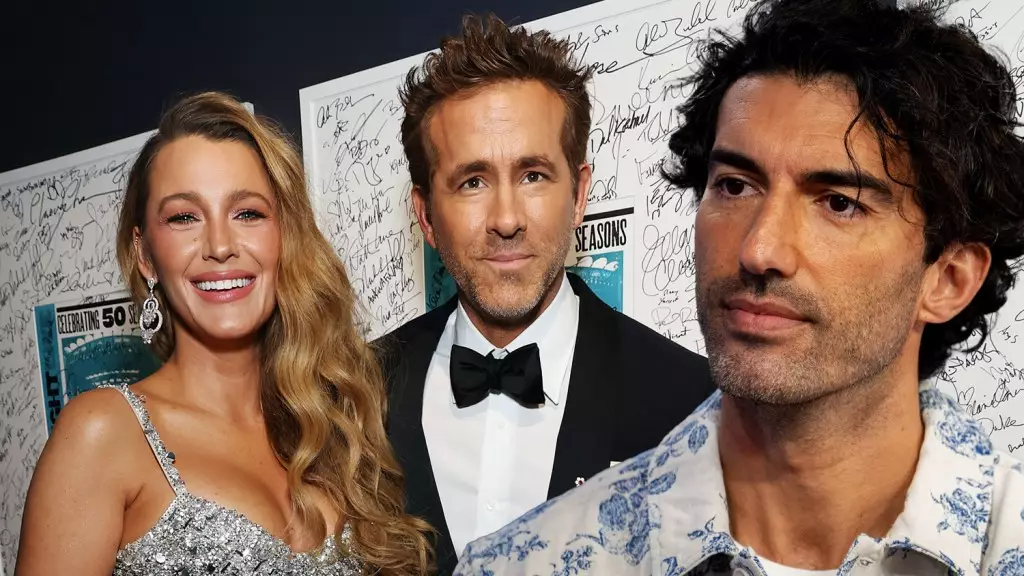The world of celebrity often drips with intrigue and sensationalism, but nothing can quite prepare the public for the unfolding drama surrounding stars Blake Lively and Ryan Reynolds, alongside Justin Baldoni. The publicity surrounding this legal battle has opened a contentious dialogue about accountability, media manipulation, and the power dynamics at play within the film industry. As the lawsuits evolve, the characters involved exhibit a complex interplay of defense, counter-claims, and public relations prowess that warrants careful examination.
At the heart of this legal turmoil is Leslie Sloane, a publicist whose ties to Lively and Reynolds have thrust her into the spotlight. Allegations from Baldoni suggest that Sloane’s agency, Vision PR, engaged in unethical practices. However, Sloane’s rebuttal reveals an astute understanding of PR operations, stating that the allegations are a “smoke and mirrors exercise” aimed at deflecting attention from the accusations against Baldoni. This dynamic reflects the broader role that public relations professionals play in managing narratives amidst crises.
Sloane’s legal team firmly argues that the claims against her lack substantive detail. They assert that the allegations of extortion and defamation have not been adequately articulated, thereby undermining Baldoni’s case. The legal assertion highlights an important aspect of public discourse: the need for clarity, accuracy, and responsibility when making serious accusations. If these claims can easily fold under scrutiny, it raises concerns about the motivations behind such legal battles, pivoting the issue toward public attention rather than factual dispute resolution.
The pressures of fame can lead to troubling power dynamics, where the lines between personal grievances and public perception become blurred. The legal fight, which includes accusations of sexual harassment and retaliation, underscores systemic issues within Hollywood that often go unaddressed. The involvement of high-profile public relations teams adds another layer, suggesting that public narratives can be crafted and manipulated to either vilify or exonerate individuals based on strategic objectives.
What’s particularly telling is the rejection of mediation between the parties. This step suggests an unwillingness to seek reconciliation or to navigate a potential resolution discreetly. Instead, both sides appear prepared for a face-off in court, set for trial on March 29, 2026. This reveals the deep divides that can form in such high-stakes disputes and paints a picture of how often celebrity disputes escalate instead of de-escalating, leading to a public inflection point rather than a private agreement.
As the details continue to emerge, there are broader implications for all involved in this case. The accusations and counterarguments not only affect the principal figures but also ripple out to impact the film industry and public notion of celebrity culture. The staggering $400 million lawsuit indicates not just a fight for personal reputation, but a financial one that highlights the weight of damage to perceived brand value.
Additionally, this case serves as a cautionary tale for publicists and celebrities alike: the tools of public relations can heavily influence narratives, but they can also backfire spectacularly. Text messages allegedly exchanged to discuss smear campaigns illustrate how fragile reputations can be and how the quest to protect a client’s image might ignite more significant public scandal.
As the trial date approaches, it remains to be seen how the court will navigate the tangled web of public relations, personal grievances, and legal ramifications. The outcome of this case could profoundly influence public perception and behavior in Hollywood, potentially setting precedents for how future claims of misconduct are handled both legally and publicly.
In a time when accountability is increasingly demanded from public figures, this case illustrates the complexities inherent in celebrity culture, as well as the ongoing struggle for truth and justice within the murky world of fame. For individuals involved, as well as for observers peering into this legal quagmire, these proceedings may redefine how public life and private realities intersect, further affecting both the public relations landscape and personal accountability in the cutthroat world of entertainment.
